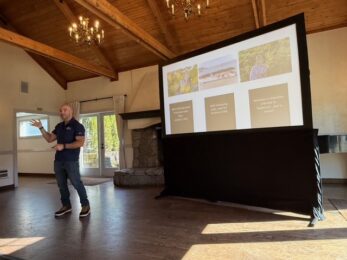Tips and methods for producing greener events
Sustainability is now required at meetings as attendees are demanding an environmentally conscious event. Curbing pollutants has become part of the meeting professional job description, but how does one do so at in-person and virtual events in a meaningful and cost-effective way? Partnering with event technology and destination experts can help cut through the green myths by taking an action-oriented, big-picture approach.
The Issue with Virtual Events
It’s easy to assume that meeting remotely is the more sustainable counterpart to in-person meetings, but what about the energy required to power the massive server farms that enable the technology? It turns out that that method of meeting isn’t as environmentally friendly as we’d all like to assume, according to a sustainable event guide produced by Universite Concordia University Montreal. The report states that “the climatic impact of virtual components of events are not trivial.” In fact, approximately 4% of greenhouse gasses in 2019 were caused by “infrastructure, equipment and data centers that allow our digital activity,” exceeding that of global waste disposal by double.
This is the result of a dramatic increase in video conferencing and the amount of electricity required to store and send it around the globe. While in-person meetings have been returning in force since 2022, hybrid and remote meetings will likely be a fixture in the meeting landscape indefinitely, but there are some simple methods for reducing the carbon footprint created by remote and hybrid technologies.
- Request that virtual attendees turn off their cameras when not presenting or interacting with other participants
- Use a cloud-based service when sending documents or videos
- Include a short note in the signature line asking the recipient to delete the message after reading to eliminate unnecessary digital storage.
These measures aren’t likely to save the polar ice caps, but they’re small steps in the right direction.
Being mindful of the pitfalls of seemingly harmless technologies (ones that we’ve become helplessly dependent on) is a great start and helpful for educating attendees and demonstrating a concerted effort to combat climate change, but the big picture requires so much more—and let’s face it—it’s often difficult to know where to start.
Eco-friendly Designs Take Shape
Bluewater Technologies Group operates with the mission to provide planners with sustainable solutions across the board when curating an event. First launched in a garage as “Bluewater Visual Services” in 1985 by two brothers who set up TVs and VCRs for local companies, Bluewater Technologies Inc. has since blossomed into a full-service AV and staging service focused on providing clients with sustainable solutions.
Bluewater Managing Partner Scott Schoenberger suggests that planners consider the following when producing sustainable events:
- Intent—all parties involved, including the event team and stakeholders must be on board
- Planning—create a strategy focused on making sustainability the guiding principle by deciding which format (in-person, hybrid or virtual) is the best option for an event and being mindful and asking questions of the technical team
- Design—including what the stage set is, the location of the event venue, what materials will be printed and what technologies will be used
“[Sustainability] has definitely become part of our DNA over the last 10-15 years,” says Schoenberger. “When we go about designing a show, we always design with a reasonable infrastructure first.” Schoenberger notes that industry standards such as shifting from incandescent lighting to LEDs, along with other types of more sustainable hardware, have aided in reducing the carbon footprint of larger events and tradeshows. “If you want to be sustainable, there needs to be intent to start with in mind as you’re planning and as you’re designing,” Schoenberger suggests planners select pieces made from materials with a clear path to a second life.
Visual displays and other fixtures are important aspects of the design of an event but selecting pieces and hardware to create displays can be done in a sustainable fashion if there’s an effort to select reusable parts during the fabrication phase. “We always look to use reusable pieces and hardware,” he says. The same intentionality can be applied to signage. “Wherever we can use a digital display, we will do that over a printed piece,” he says, adding, “The cost of technology is coming down to the point where this is becoming a viable option for many brands and businesses.”
Some of these technologies can have multiple purposes, Schoenberger says, including LED walls that in some cases won’t be used to display any graphics at all, but can be used as a set piece that can be taken down and reused during other events. An even more aggressive strategy in sustainability can include the exact color of lights used in displays, opting to exclude white LEDs due to the increased amount of energy needed to produce that spectrum of light.
While virtual events are not free of creating carbon emissions, Schoenberger suggests that planners consider hybrid or virtual events to offset the carbon emissions produced by extended air travel due to the location of a proposed host city.
Civil Sustainability
Local destination organizations have begun pitching in on the effort to assist in the curation of sustainable meetings as well. Visit Oceanside in California is spearheading the first sustainable master plan in the state following the criteria provided by the Global Sustainable Tourism Council (GSTC). The blueprint of the new sustainability plan follows a 10-year roadmap with the goal of ushering in sustainable growth in tourism for the San Diego County-based destination, placing an emphasis on benefitting the economy, environment, residents and visitors.
“Over the last 10 years, Oceanside has realized so much of its potential as a visitor destination, and our goal is to nurture future progress in a way that continues to impact the community for good,” according to Visit Oceanside CEO Leslee Gaul. “This process is really a reflection of our love for this city and our desire for it to thrive for many years to come.”
Visit Oceanside’s Sustainable Tourism Master Plan aims to achieve four specific goals to support a sustainable future for the destination with an initial phase of conducting a sustainability assessment, destination assessment, competitive analysis and stakeholder engagement, according to an announcement released in early January.
Bringing the goals outlined in the Sustainable Tourism Master Plan to fruition through a collaboration between Visit Oceanside and the City of Oceanside will likely ensure an elevated meetings experience for attendees that will boost the local economy, preserve the quality of life of residents and protect the environment. Planners can take advantage of Oceanside’s wide variety of meeting facilities, lodging options and a fantastic selection of activities, while actively contributing to a sustainable future—all on the beautiful California coast.
“The pandemic shed a light on the importance of a holistic approach to tourism that balances economic benefit with quality of life for residents and health of the destination,” Gaul said. “We are proud that Oceanside has not only taken a lead in formalizing this effort, but also committed to measuring our future product development, policies and achievements against the leading standard for sustainability in the world.”




